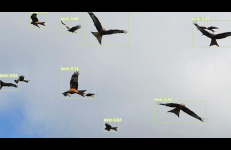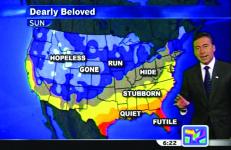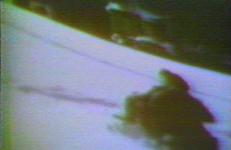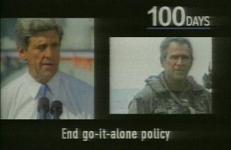Functioning as both a fake documentary and a fake advertisement, Meet the People deals with issues of desire, complicity, and identity in the age of mass media, as 14 “characters” talk about their lives, desires, and dreams.
Media Analysis
Mike Builds a Shelter is a performance comedy with apocalyptic overtones, a narrative extension of Smith's installation Government Approved Home Fallout Shelter/Snack Bar. In this darkly humorous morality play, Smith contrasts Mike's rural adventures in a pastoral landscape with his home fallout shelter. Throughout, the dual narratives are intercut with episodes of Mike's Show on cable, in which Mike's banal domestic activities are eagerly if passively received by living-room TV viewers.
Intertwining associated experiments in image and sound generation using AI, Nearest Neighbor focuses on language acquisition and mimicry between humans, birds and machines, asking fundamental questions about consciousness, learning and understanding. The film is a contemporary reflection on the state of technology in relation to the natural world. It asks us to think about what we want from inter-species communication and what we expect from technologies that aspire to substitute for living beings.
Intertwining associated experiments in image and sound generation using AI, Nearest Neighbor focuses on language acquisition and mimicry between humans, birds and machines, asking fundamental questions about consciousness, learning and understanding. The film is a contemporary reflection on the state of technology in relation to the natural world. It asks us to think about what we want from inter-species communication and what we expect from technologies that aspire to substitute for living beings.
The second installment of the collaborative project New Report, an ongoing series of performances and videos, Artist Unknown features K8 Hardy (founder of the queer feminist art collective LTTR) and Wynne Greenwood (of Tracy and the Plastics) playing Henry Irigaray and Henry Stein-Acker-Hill, and anchor and roving correspondent for WKRH, a feminist TV news station whose tagline is "pregnant with information." Based on documentation of a live, digital communication in real time between Greenwood at Foxy Production Gallery and Hardy on the street in New York.
The second installment of the collaborative project New Report, an ongoing series of performances and videos, Artist Unknown features K8 Hardy (founder of the queer feminist art collective LTTR) and Wynne Greenwood (of Tracy and the Plastics) playing Henry Irigaray and Henry Stein-Acker-Hill, and anchor and roving correspondent for WKRH, a feminist TV news station whose tagline is "pregnant with information." Based on documentation of a live, digital communication in real time between Greenwood at Foxy Production Gallery and Hardy on the street in New York.
A combination of experimental and narrative approaches which explore the commodification of rebellion as it is marketed to youth culture, through the eyes of two drug-dealing, teenage girls from Brooklyn who "accidentally" kill and mutilate their favorite alternative rock star. Their obsession with murders and makeovers and their confusion between fashion and transgression lead these girls into a world where nihilism is bought and sold, and rebellion is impossible.
This tape is a critique of the blockbuster film Top Gun and the attitudes of macho militarism that it embodies. The tape uses the unpopulated space of a fast food chain parking lot and the runway at Miramar Naval Air Station to present facts about the vast wasteland of American military spending. These segments are contrasted with promotional clips from Top Gun that condense the ideas of the film into 30-second spots.
Inspired by a riff on a popular joke “Everybody wanna be a black woman but nobody wanna be a black woman,” Notes On Gesture is a video comparing authentic and dramatic gestures. The piece uses the 17th Century text Chirologia: Or the Natural Language of the Hand as a guide to create an inventory of gestures for performance. The piece alternates between title cards proposing hypothetical situations and short, looping clips that respond. The actor uses her body to quote famous, infamous, and unknown women.
“Now too late, he understood her. The heart that pumped out love, the mouth that spoke the Word, didn’t count.”
--Toni Morrison, “Beloved”
On Subjectivity examines how information is disseminated, how people read, screen, and interpret images; how mechanisms function and articulate information. How are we affected by what the networks choose to give us, and how do we choose to interpret what we see? Considering diverse interpretations influenced by cultural difference, levels of perception, and the manipulation of the image, Muntadas provokes inquiry into the potential of television and consideration of the intentional and unintentional influence of television on our daily lives.
Take a joyride through comfortable suburbia—a landscape molded by seductive television and corporate America (and keep in mind: disaster is another logo for your consumption...). This is the age of the "culture jammed" consumer preened with Friends hair, Survivor courage, and CNN awareness. A generation emptying their wallets for the most important corporate product of all: lifestyle. The psychological road trip across a slightly battered America travels at One Mile per Minute.
The four‐part cycle Parallel deals with the image genre of computer animation. The series focuses on the construction, visual landscape and inherent rules of computer-animated worlds.
“Computer animations are currently becoming a general model, surpassing film. In films, there is the wind that blows and the wind that is produced by a wind machine. Computer images do not have two kinds of wind.”
-- Harun Farocki
The four-part cycle Parallel deals with the image genre of computer animation. The series focuses on the construction, visual landscape and inherent rules of computer-animated worlds.
"Computer animations are currently becoming a general model, surpassing film. In films, there is the wind that blows and the wind that is produced by a wind machine. Computer images do not have two kinds of wind."
— Harun Farocki
The four‐part cycle Parallel deals with the image genre of computer animation. The series focuses on the construction, visual landscape and inherent rules of computer-animated worlds.
"Computer animations are currently becoming a general model, surpassing film. In films, there is the wind that blows and the wind that is produced by a wind machine. Computer images do not have two kinds of wind."
— Harun Farocki
The four‐part cycle Parallel deals with the image genre of computer animation. The series focuses on the construction, visual landscape and inherent rules of computer-animated worlds.
"Computer animations are currently becoming a general model, surpassing film. In films, there is the wind that blows and the wind that is produced by a wind machine. Computer images do not have two kinds of wind."
—Harun Farocki
Paul Schrader’s Bag is an inventory of fame. Playing the anonymous Every Man in a brush with celebrity, Simon presents a Hollywood peerage as our cultural patrimony.
This title is also available on Jason Simon: Three Videos.
Vice President Mike Pence eagerly plays cheerleader in chief for Donald Trump. In accepting the vice-presidential nomination in 2016, Pence proclaimed, “I'm a Christian, a conservative, and a Republican — in that order,” suggesting how we might understand his role. This ground-breaking, earth-shaking video begins with a pomp-ridden televised press conference, accompanied by uplifting music. Held early in 2017 at the White House Rose Garden, it showcased the president’s announced withdrawal from the historic Paris Climate Accord.
Appropriating material from the introduction to the nightly television show, PM Magazine and a commercial for Wang Computers, Birnbaum uses enlarged still-frames from each of the sources to compound a new image of the indelible American Dream. To the soundtrack of an acid rock version of The Doors' L.A. Woman, repetitive images of an ice skater, baton twirler, cheerleader, and young girls licking ice cream, exemplify dominant cultural images of women — images that emphasize their performative nature: the idea that woman is a spectacle arranged for the (male) viewer's pleasure.
Presidential candidates are sold like commercial products and naturally television is the ideal medium. Political Advertisement depicts the evolution of political ads over the last 44 years, beginning with Eisenhower in 1952 (which was an unqualified success), and continuing up to the most recent ad campaigns for Ross Perot, Bob Dole, and Bill Clinton in 1996.
Presidential candidates are sold like commercial products and naturally television is the ideal medium. Political Advertisement depicts the evolution of political ads over the last 44 years, beginning with Eisenhower in 1952 (which was an unqualified success), and continuing up to the most recent ad campaigns for Ross Perot, Bob Dole, and Bill Clinton in 1996.
Antonio Muntadas and Marshall Reese have been documenting the selling of the American presidency since 1984, and have expanded and updated the series with every election. Political Advertisement 2000 features ads from the 1950s up to the 2000 campaign. As Muntadas and Reese trace the development of the TV spot, what emerges is the political strategy and manipulative marketing techniques of the American televisual campaign process. Political Advertisement 2000 includes many rare spots, some never before seen.
Antonio Muntadas and Marshall Reese have been documenting the selling of the American presidency since 1984, and have expanded and updated the series with every election. Political Advertisement 2000 features ads from the 1950s up to the 2000 campaign. As Muntadas and Reese trace the development of the TV spot, what emerges is the political strategy and manipulative marketing techniques of the American televisual campaign process. Political Advertisement 2000 includes many rare spots, some never before seen.
The latest in Muntadas and Reese's series documenting the selling of the American presidency features political ads from the 1950s to ads from the 2004 campaigns, and highlights the development of the political strategy and marketing techniques of the TV campaign process.
Edited without commentary, the artists show an endless stream of candidates, from Eisenhower to Kerry, who are marketed like commercial products. As Muntadas and Reese trace the development of the campaign TV spot, what becomes apparent is a consistent sameness of political issues amid complex, changing visuals.
The latest in Muntadas and Reese's series documenting the selling of the American presidency features political ads from the 1950s to ads from the 2004 campaigns, and highlights the development of the political strategy and marketing techniques of the TV campaign process.
Edited without commentary, the artists show an endless stream of candidates, from Eisenhower to Kerry, who are marketed like commercial products. As Muntadas and Reese trace the development of the campaign TV spot, what becomes apparent is a consistent sameness of political issues amid complex, changing visuals.






















